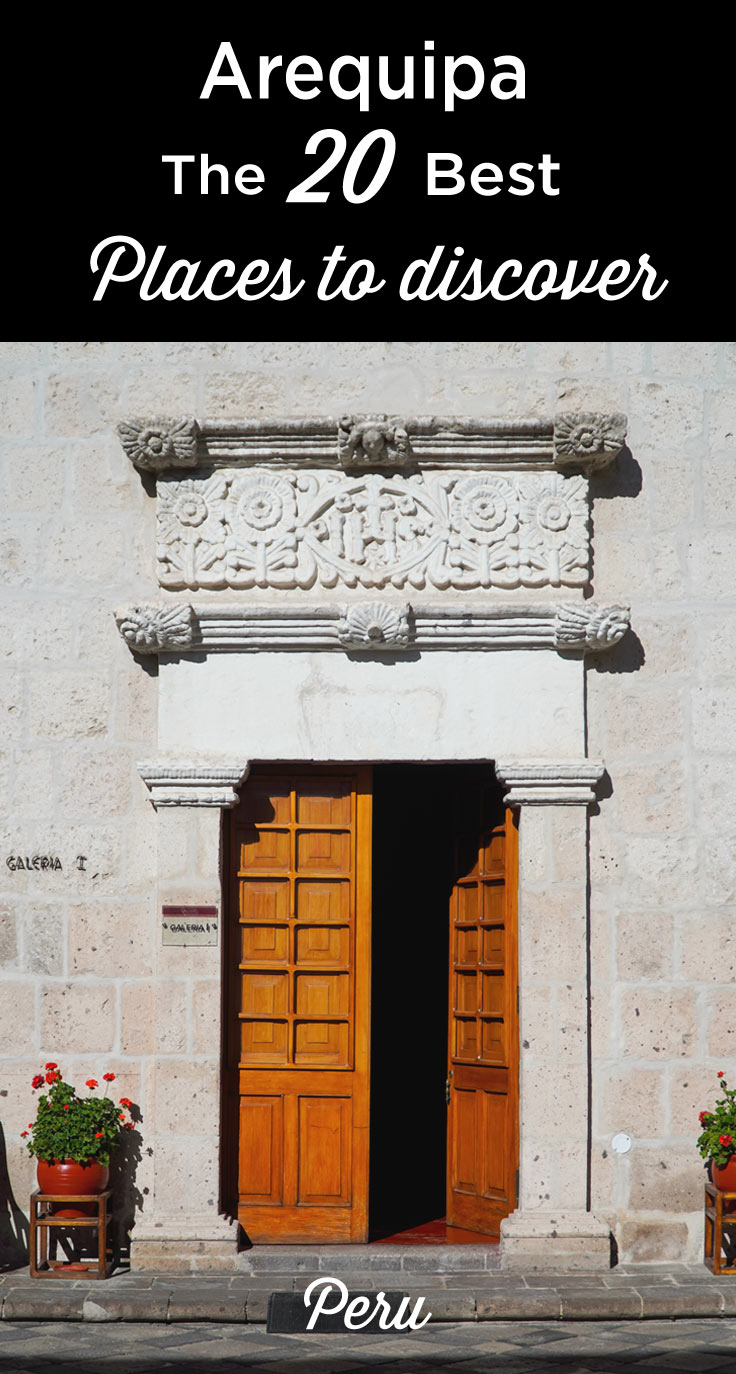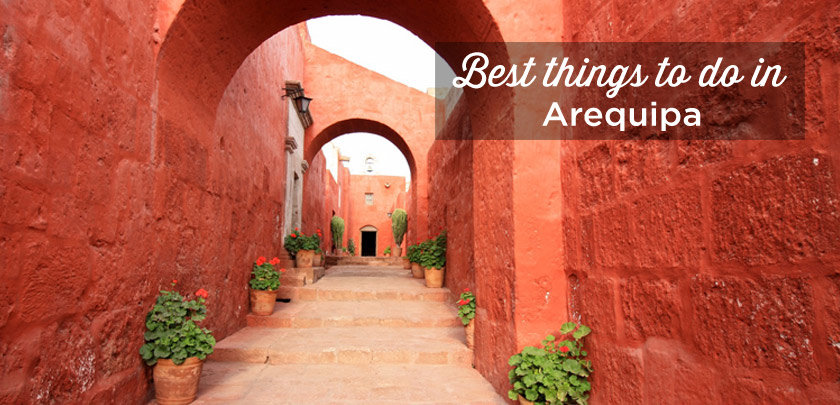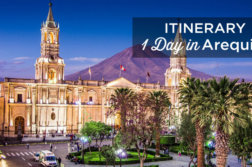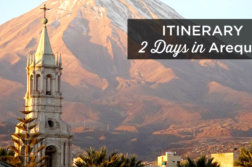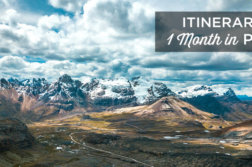Arequipa (Peru): Best places to visit + Where to stay
Visiting Arequipa means exploring one of the most beautiful cities in Peru, famous for its colonial charm and bright white buildings made from volcanic stone. It’s a city full of elegant architecture, peaceful plazas, and narrow, picturesque streets that invite you to slow down and wander.
It’s also the perfect starting point to visit the impressive Colca Canyon, the second deepest canyon in the world and one of Peru’s unmissable highlights!
To help you plan your trip, I’ve put together a complete guide to Arequipa—also known as “The White City”—with all the top things to do, places to visit, and my favorite restaurants and hotels for every budget.
If you’re short on time, don’t miss my article on spending 2 days in Arequipa, with a ready-to-follow itinerary and practical tips to make the most of your stay.
So, what are the best things to do in Arequipa? Where should you stay? Let’s dive in!
Sommaire
- Arequipa (Peru): Best places to visit + Where to stay
- 1. The Plaza de Armas
- 2. The Cathedral
- 3. Church of La Compañía
- 4. Convent of Santa Catalina
- 7. The famous mummy Juanita
- 8. District of Yanahuara
- 9. La Recoleta
- 10. Eating in a picanteria
- 11. Try the ice cheese
- 12. Take a gastronomic tour
- 13. See llamas and alpacas in the middle of the city
- 14. Discover Arequipa’s traditional neighborhoods
- 15. Colca Canyon
- 16. Sillar Route
- 17. Salinas Lagoon
- 18. The waterfalls of Pillones
- 19. Cotahuasi Canyon
- 20. Rafting on the Chile River
- Lodging in Arequipa – Where to stay?
- Where to eat in Arequipa: restaurants and cafes
- Where to have a drink in Arequipa
- Tourist map of Arequipa
- How many days to visit Arequipa?
- When to visit Arequipa?
- My tips for visiting Arequipa
- How to get to Arequipa?
- Rent a Car in Peru
- Traveling to Peru? These articles will help you!
1. The Plaza de Armas
As in all major Latin American cities, the Plaza de Armas is the heart of the city.
Many say it is the most beautiful square in Peru, with its lively crowd, palm trees and central fountain.
It is surrounded by the cathedral, the Iglesia de la Compañía and three streets lined with arcaded colonial buildings.
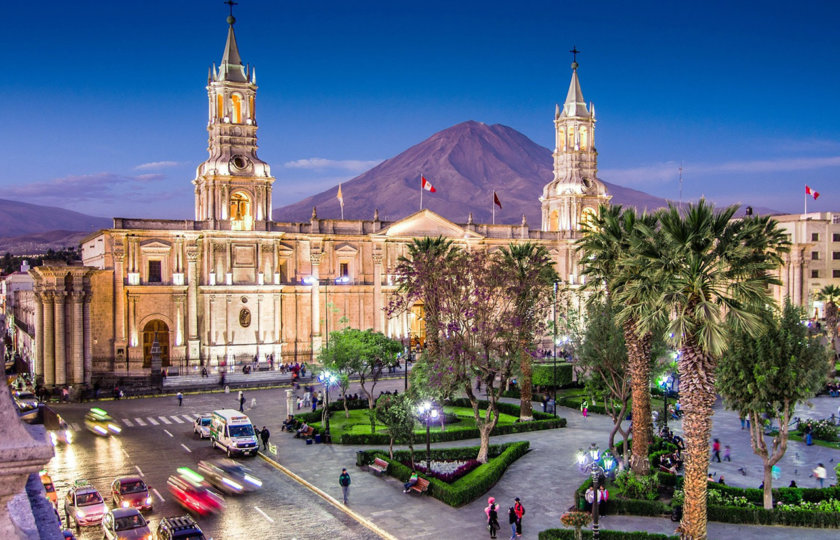
2. The Cathedral
Arequipa’s cathedral dates back to 1612, but was rebuilt in the 19th century due to the numerous earthquakes and fires that damaged it.
It is a neoclassical building that houses an imposing Belgian organ (one of the largest in South America!), a large Sevillian chandelier, a huge Carrara marble altar and a remarkable wooden pulpit carved by the Frenchman Charles Buisine-Rigot.
The guided tour includes the cathedral, the museum containing 400 years of history and access to the bell tower, from where you get one of the best views of the city!
Visit the cathedral
- Guided tour: 10 soles – adults, 3.50 soles – students
- Hours: Monday to Saturday, 7:00 a.m. to 11:30 a.m. and 5:00 p.m. to 7:30 p.m.; Sunday: 7:00 a.m. to 1:00 p.m. and 5:00 p.m. to 7:00 p.m
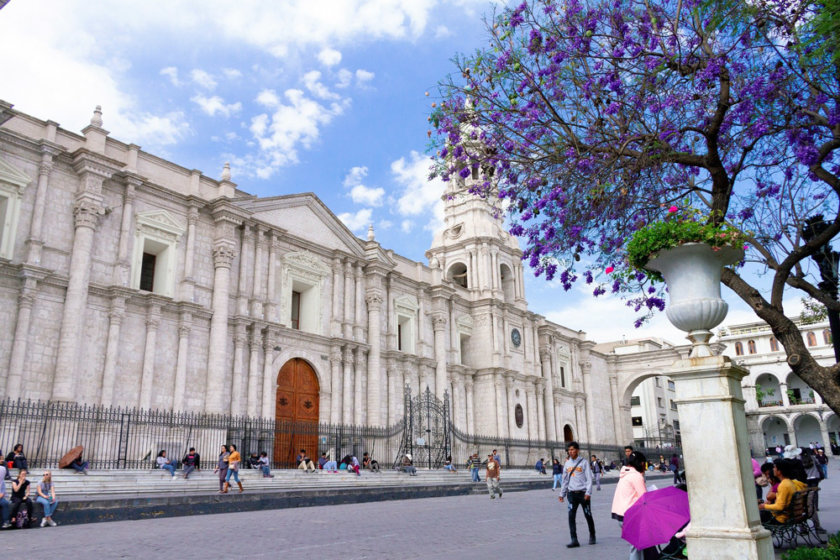
3. Church of La Compañía
On the corner of the main square is the Iglesia de la Compañía, founded by the Jesuits. It is a magnificent example of mestizo baroque architecture.
In fact, both Christian and Inca symbolism can be observed: Christian angels can be seen conversing with figures from Inca mythology!
Inside, there are several altarpieces carved in wood and covered with gold leaf.
Within the sacristy you will find the chapel of San Ignacio (5 soles) completely covered with frescoes of tropical flora and fauna.
You can also visit the beautiful cloister built with volcanic stone. From there, climb the stairs to the upper gallery that offers a beautiful view of Arequipa.
Tip: go there at sunset, the light is magnificent!
Visit the Iglesia de la Compañía
- Admission: free
- Address: Alvarez Thomas Street
- Hours: 9am-12am, 3pm-6pm
- In the cloister you will find a pleasant cafeteria and La Benita de los Claustros (opens at 12h), a small but very good restaurant.
4. Convent of Santa Catalina
For me, the Santa Catalina Convent is the most beautiful place to visit in Arequipa—an absolute must-see!
It’s not just a convent: it’s so vast that it feels like a real city within the city, with its narrow cobbled streets, colorful buildings in white, red, and blue, peaceful courtyards, fountains, and flower-filled gardens.
In its prime, the Monastery of Santa Catalina de Siena was home to up to 500 nuns from wealthy families.
But life here wasn’t exactly austere: each nun had her own maids and ate from fine porcelain with silver cutlery. They even organized parties with live music!
This lavish lifestyle eventually reached the ears of Pope Pius IX, who decided to put an end to it in 1871. After being closed to the outside world for nearly 400 years, the convent finally opened to the public in 1970.
You can walk around on your own, but I really recommend taking a guided tour. There’s so much to learn about the history of the place, and the guides do a great job bringing it all to life.
And the best part? You’re free to explore at your own pace once the tour is over!
- If you want great photos, try to go early in the morning—you’ll avoid the crowds and enjoy the calm atmosphere.
Visit the Monastery of Santa Catalina
- Admission: 45 soles for adults, 20 soles for students (under 21), 20 soles for guides (with tip).
- Address: Calle Santa Catalina, 301, Arequipa
- Hours: daily from 9:00 a.m. to 6:00 p.m. (last entrance at 5:00 p.m.). Possibility of visiting the convent at night with candles that illuminate the place and create a unique atmosphere (Thursdays from 5:30 p.m. to 8:30 p.m. – last entrance at 7:30 p.m. – except in January, February and March).
- Website
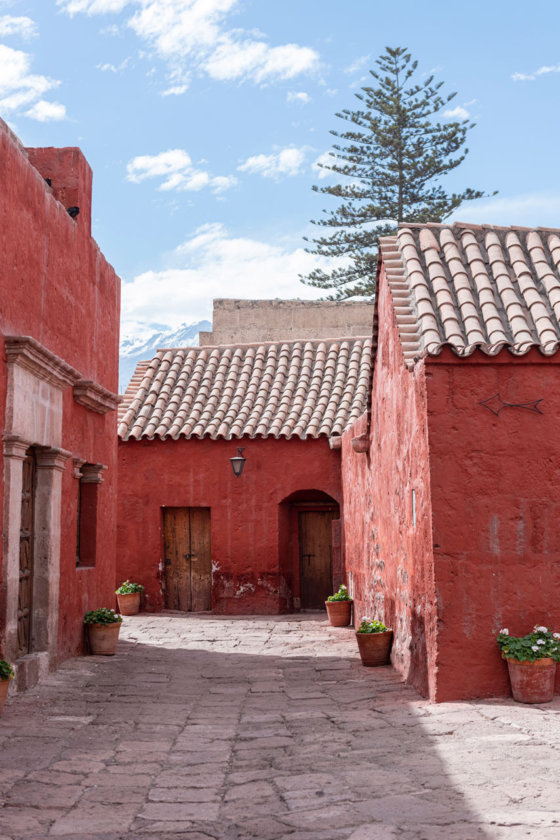
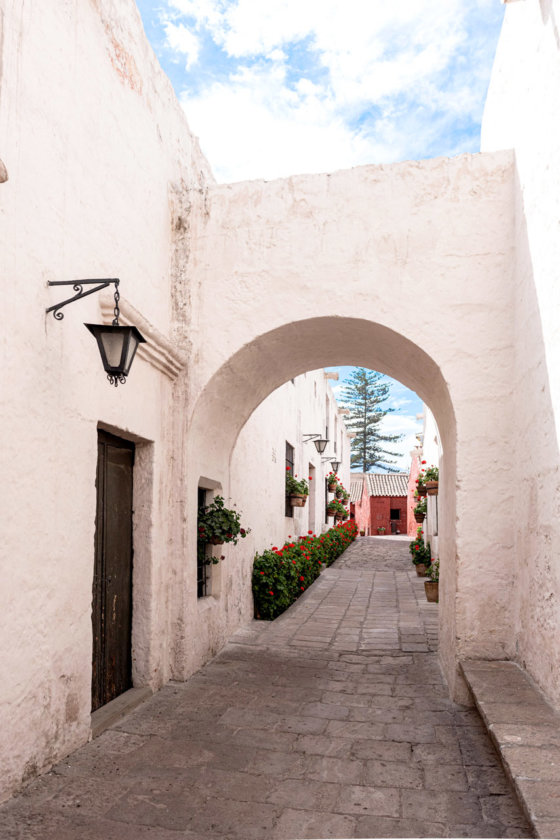

7. The famous mummy Juanita
The Museum of Andean Sanctuaries is a small museum that houses the famous Juanita mummy, also called the ice princess.
It was discovered in 1995 by the American mountaineer Johan Reinhard, at an altitude of 20,679 foot, near the summit of Mount Ampato.
It is the mummified body of a young Inca girl who was sacrificed according to their rites, and preserved in the ice for 500 years before the heat of volcanic activity melted the snow.
Thanks to this ice, she was a treasure trove for archaeologists and historians: her tissues and bodily fluids were very well preserved, revealing clues about the hygiene and diet of the time!
You can also see objects found with her and watch a documentary about her discovery. The visit is usually guided and tipping at the end of the tour is highly recommended.
Visit the Museum of Andean Sanctuaries
- Admission: Adults 25 soles, children and students 15 soles
- Address: 110 La Merced Street, Arequipa
- Hours: Monday to Saturday from 9:00 a.m. to 6:00 p.m., Sundays from 9:00 a.m. to 3:00 p.m
- Address: Santa Catalina 210, Arequipa
- Website
They’re not touristy at all, but they’re free and housed in beautiful historic buildings—definitely worth a quick visit if you’re nearby:
- The UNSA Archaeological Museum, which displays 177 pre-Columbian objects, including mummies.
- The MUCEN Art Museum, featuring a small but interesting collection of colonial and archaeological art.
Perfect if you’ve got a little time between two visits!
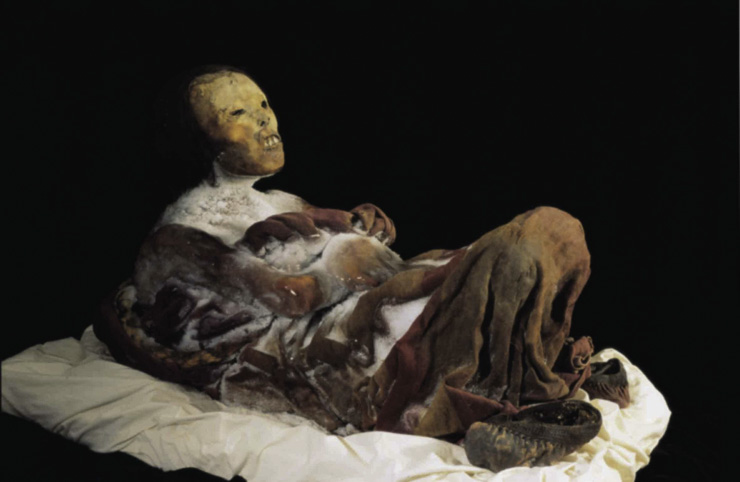
8. District of Yanahuara
From downtown Arequipa, take the Grau Bridge to reach the beautiful Yanahuara district.
It is known mainly for its picanterías (typical restaurants) and for the Yanahuara viewpoint, which offers an excellent place to admire the city and the surrounding volcanoes!
The viewpoint is located in the beautiful Plaza de Yanahuara, along with the Church of Yanahuara and Charito, where you can taste a good local ice cream (queso helado).
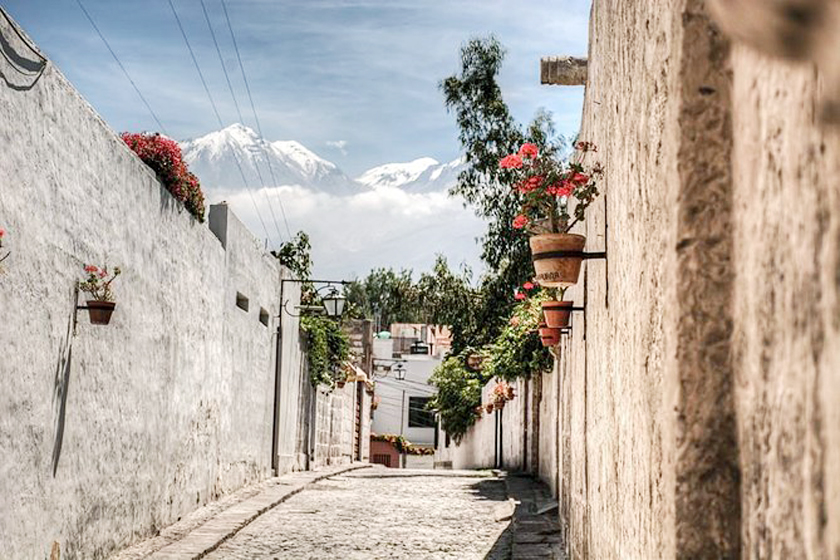
9. La Recoleta
On the way to Yanahuara from the historic center, you should not miss the Monastery and Museum of La Recoleta, with its 4 cloisters and gardens.
You can visit its numerous rooms that exhibit mummies, masks, objects and animals brought back from the missionaries’ expeditions to the Amazon, as well as religious and pre-Hispanic works of art, convent utensils and old photographs.
The bookstore is an important element of the museum, with 20,000 books, documents and maps (including the first maps of the city), some of which are more than 500 years old!
Visit the Recoleta Monastery and Museum
- Entrance fee: 10 soles, tipping the guide is suggested.
- Address: Calle Recoleta, 117, Arequipa
- Hours: Monday to Saturday from 9:00 am to 12:00 pm, from 3:00 pm to 5:00 pm, closed on Sundays
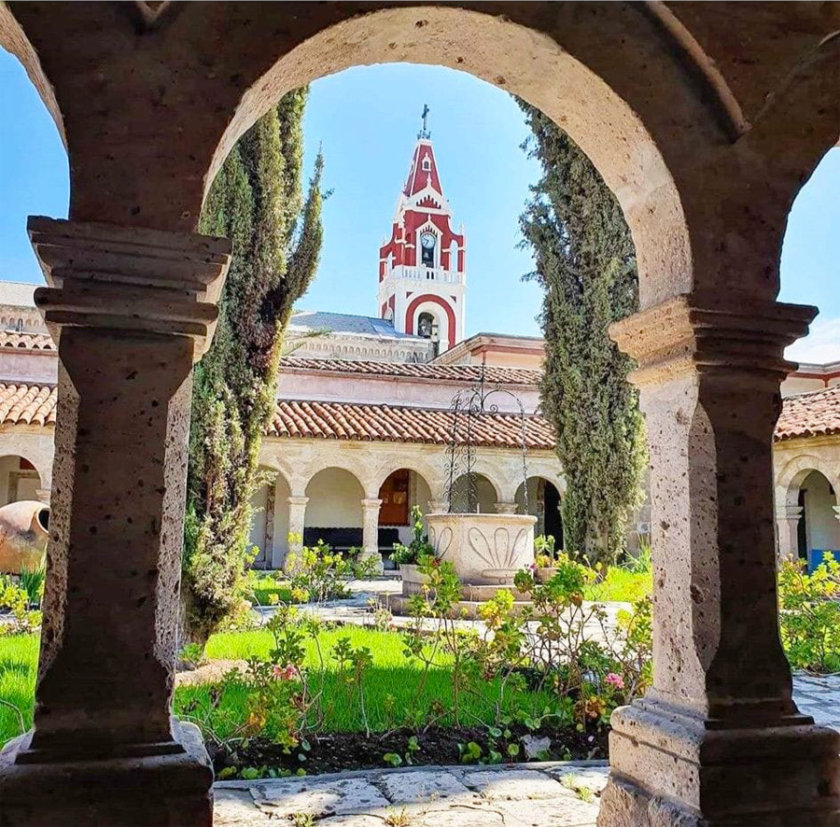
10. Eating in a picanteria
You can’t visit the city without going to a picantería!
They are traditional restaurants that serve typical dishes of Arequipa.
There are several, but I prefer La Nueva Palomino, a nice picantería with good service, which is one of the most famous in the city.
To try several specialties, I chose the Picantero Caliente (41 soles) with manioc, fried cheese and “torrejas”, which look like small fried tortillas with vegetables.
All portions are large and I recommend sharing unless you have a big appetite.
You can take the opportunity to try the Cerveza Arequipeña (10 soles a large bottle), the beer of Arequipa, and the rocoto relleno con pastel de papa, a delicious typical Arequipa dish.
La Nueva Palomino
- Address: Leoncio Prado, 122, (Yanahuara), Arequipa
- Facebook of La Nueva Palomino
- Open every day from 12:00 noon to 4:30 pm
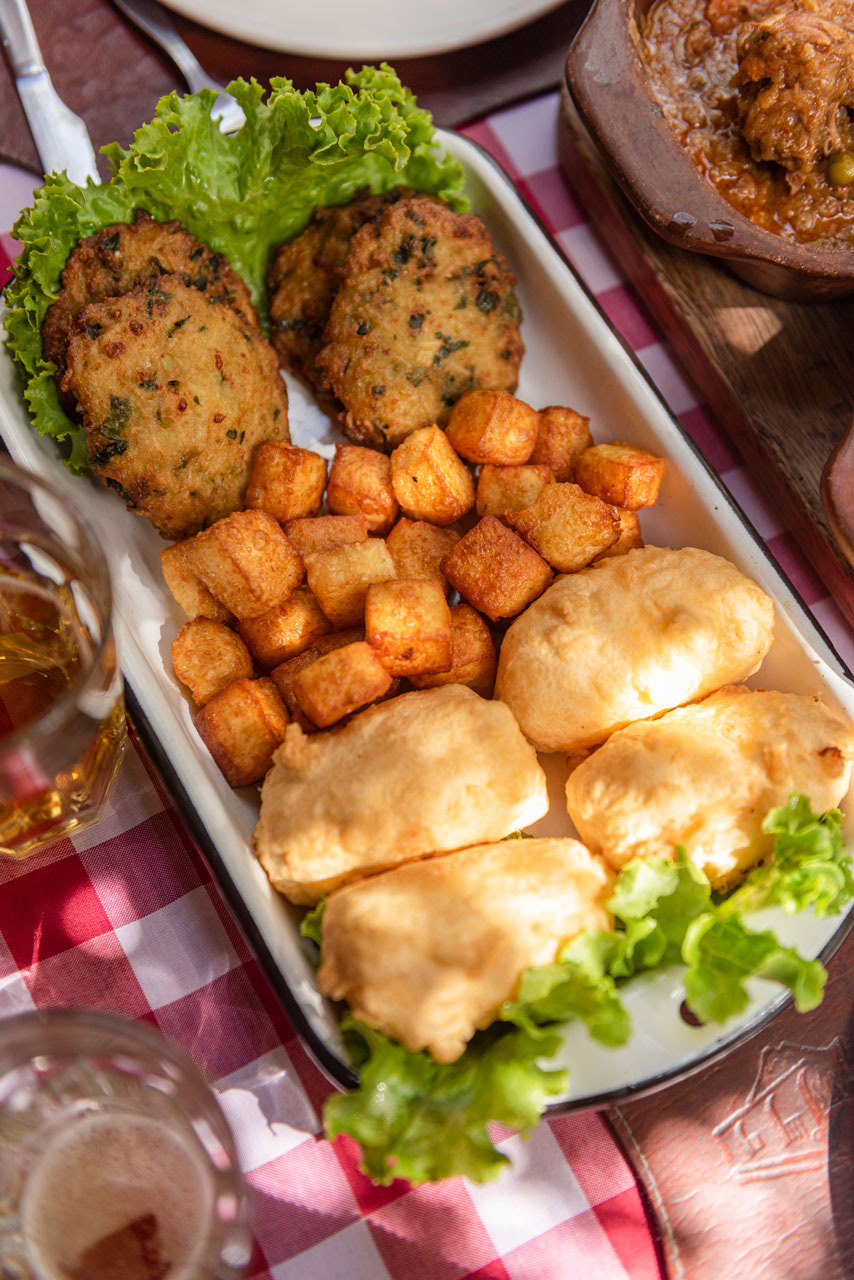
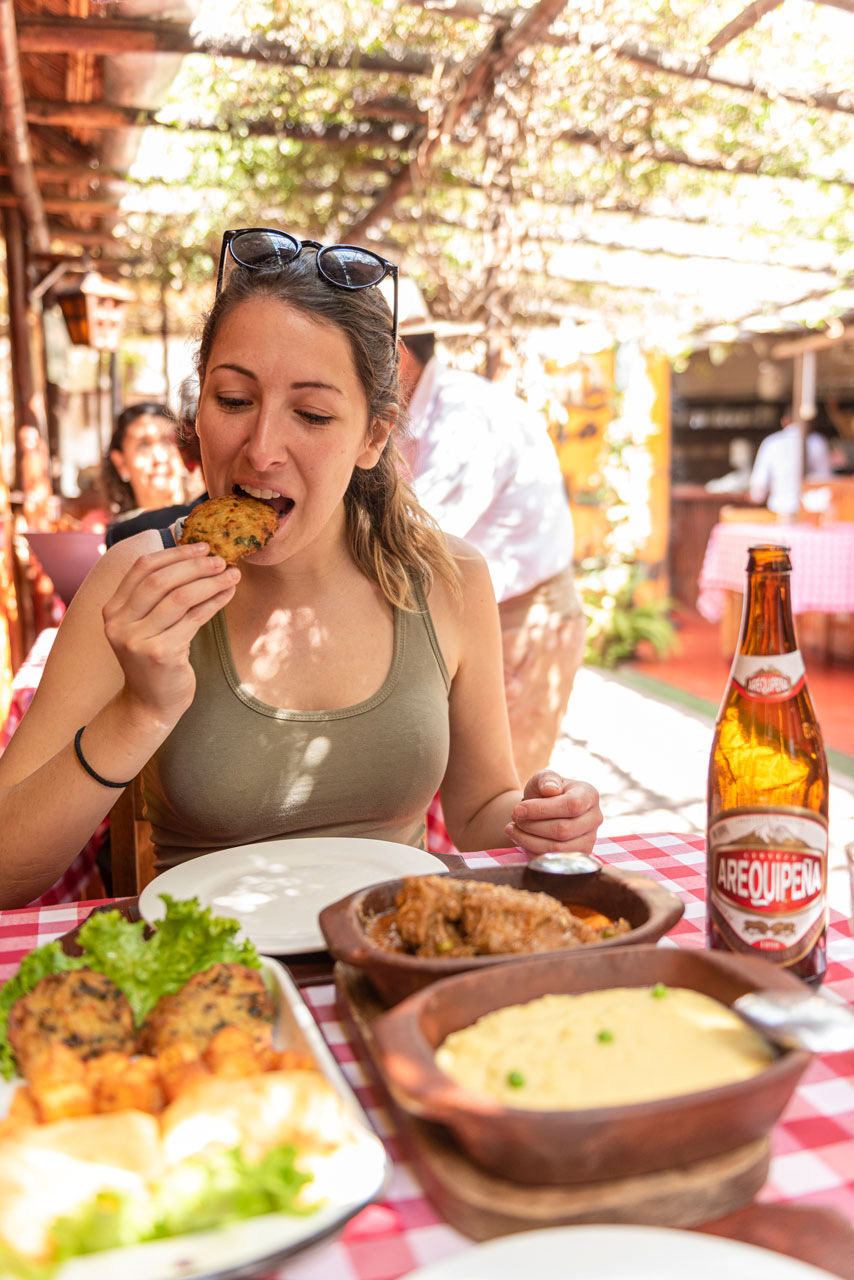
11. Try the ice cheese
Queso helado is a typical dessert from Arequipa.
Its name is misleading because it does not have cheese, but simply milk, condensed milk, cinnamon and coconut.
There are vendors everywhere, and it costs only a few soles!
My favorite is Doña Rosa’s, in the San Camilo Market, but I like the Charito’s queso helado, in Yanahuara, since it is just a few steps from the viewpoint.
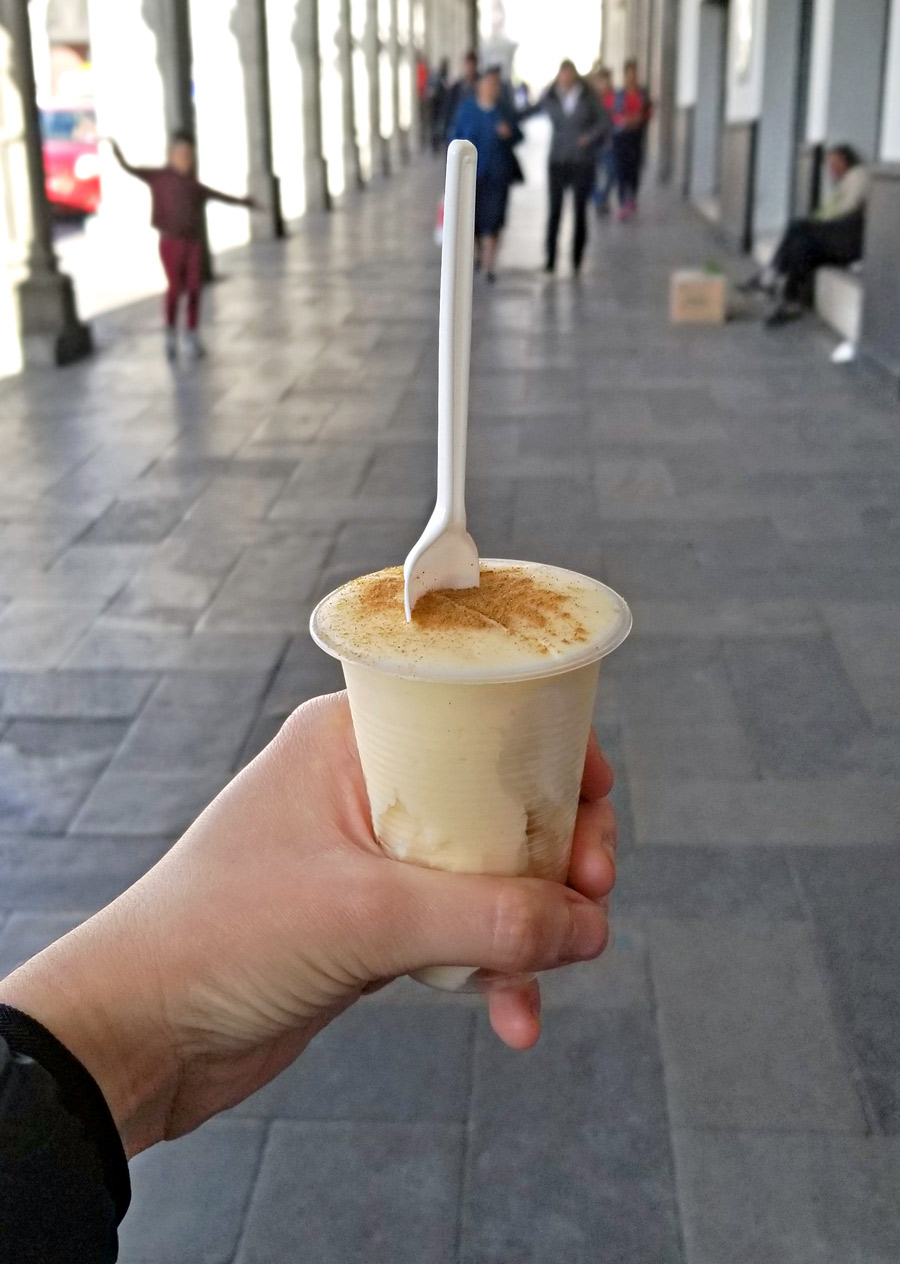
12. Take a gastronomic tour
For a more complete immersion in Arequipa’s gastronomy, I really recommend taking the guided tour with Exquisito Peru.
They are passionate about Peruvian gastronomy and have already created two fantastic tours in Lima, now they have expanded and host a tour in Arequipa.
They always find interesting addresses, the guides are friendly, the portions are generous and you end up very much full!
You can book the Arequipa culinary tour here:
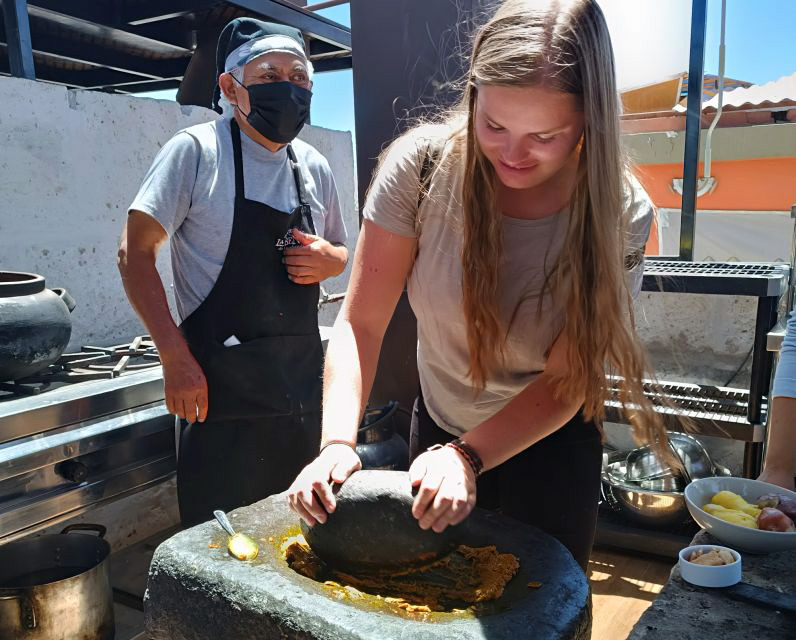
13. See llamas and alpacas in the middle of the city
Mundo Alpaca is a store where you can buy quality authentic alpaca wool clothing (so it requires some budget), but personally I find that its big attraction is that you can access for free to the enclosure where the llamas and alpacas are.
Apparently, I was too excited about the cute camelids and an alpaca spit on me! It was the first time this had happened to me and, unlike Captain Haddock, it made me laugh!
But be careful not to get too close.
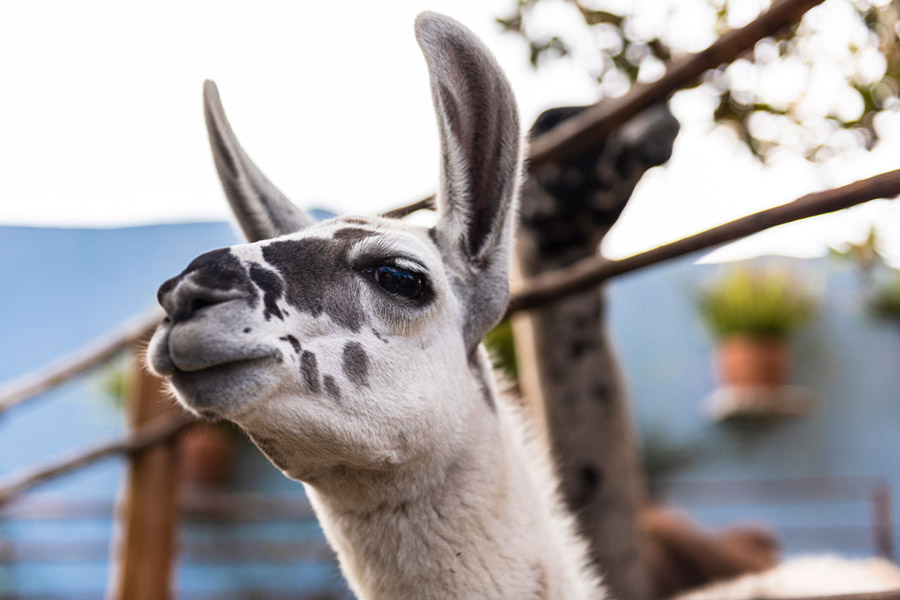
There is also a sort of small exhibition on the types of wool, the ingredients used for natural dyeing and photos. If you’re lucky, you can even see a weaver at work (she’s not always there).
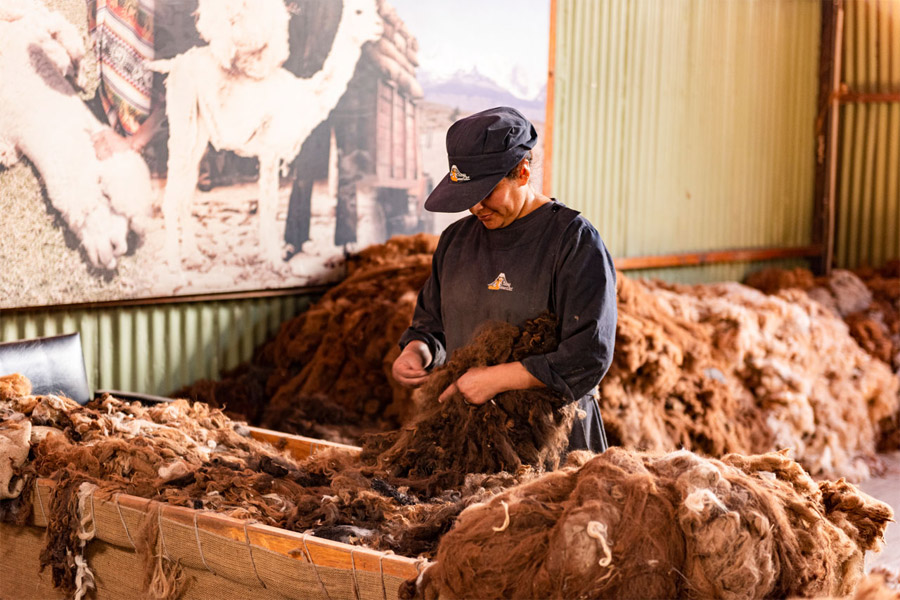
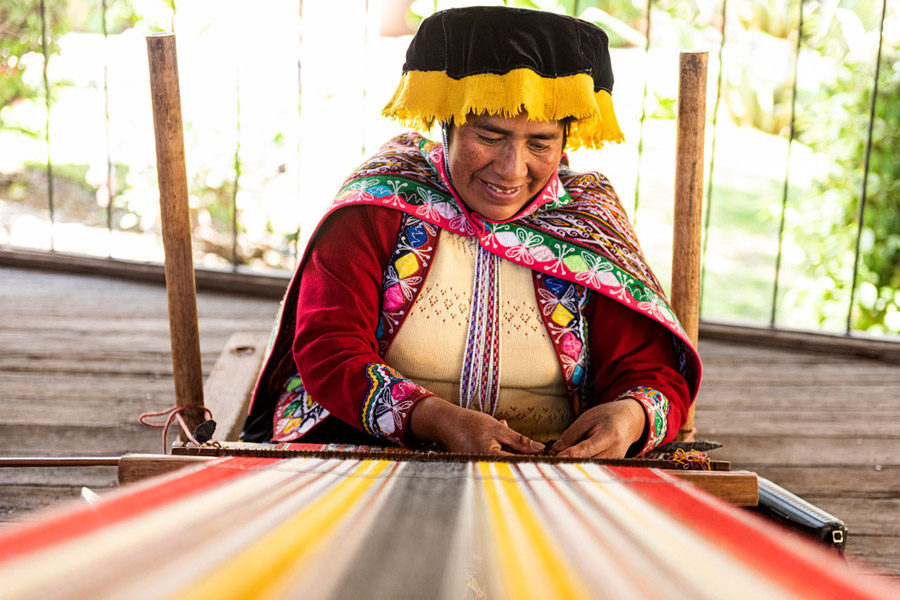
14. Discover Arequipa’s traditional neighborhoods
In addition to the beautiful neighborhood of Yanahuara, there are two other neighborhoods worth visiting.
They are not very touristic, but they are located in the historic center, very close to the cathedral!
The Solar neighborhood
It is a very small neighborhood and, honestly, its only attraction is its streets, but boy they are pretty, narrow and lined with flowers and benches.
From the largest square, it is best to take the street Puente Bolognesi (with a stop at the Kafi Wasi cafe, very nice) and then enter through the Puerta del Puente.
Neighborhood of San Lazaro
Like the Barrio del Solar, the Barrio de San Lazaro is one of the oldest in Arequipa and is characterized by its narrow cobblestone streets and white ashlar houses.
You can stroll through Bayoneta, Violin, Los Cristales, Plaza de Campo Redondo and Alameda San Lazaro.
In the evening, I suggest you have a good craft beer at Chelawasi o Nowhere which has a rooftop terrace.
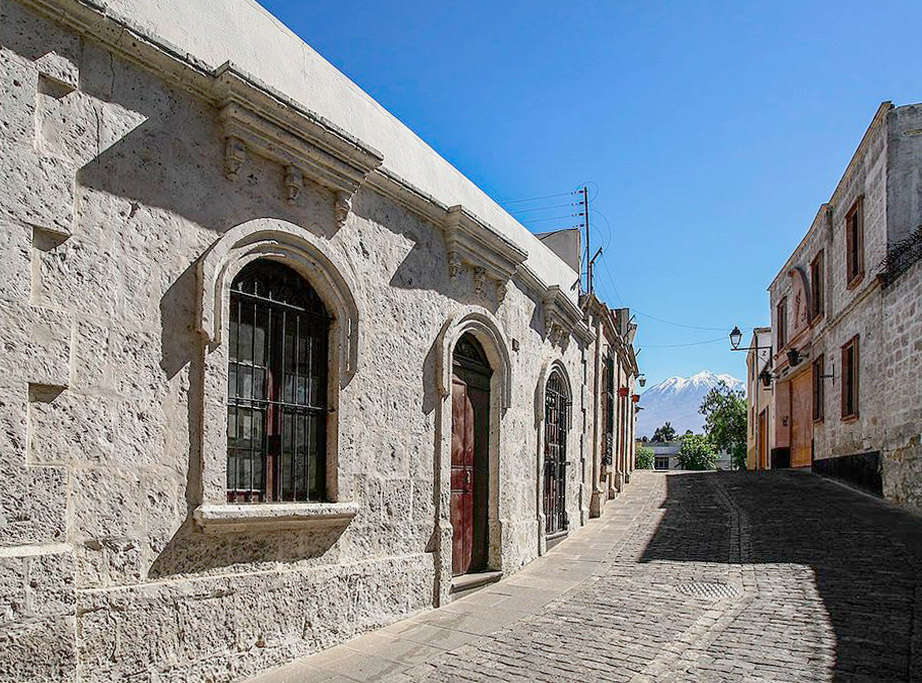
15. Colca Canyon
The second deepest canyon in the world, right after its neighbor the Cotahuasi Canyon, is the Colca Canyon, a great must-see of Arequipa and one of the most beautiful destinations in Peru.
It houses:
- Magnificent Andean landscapes between volcanoes and agricultural terraces, with llamas and alpacas.
- The fabulous Andean Condor, the largest bird in the world, which can be easily seen from the viewpoint of the Cruz del Condor.
- Small picturesque villages such as Chivay, Yanque, Coporaque, Cabanaconde and many others less known.
- Hot springs (La Calera and Sallihua)
- The possibility of making a 2 or 3 days trekking in the Colca – Check here Hugues’ experience
To know everything about the region (activities, practical information, transportation, etc.) I invite you to read my Definitive Guide to the Colca Canyon!
If you plan to continue on to Lake Titicaca, there is also the very convenient option of booking a 2-day Colca Tour with transfer to Puno.
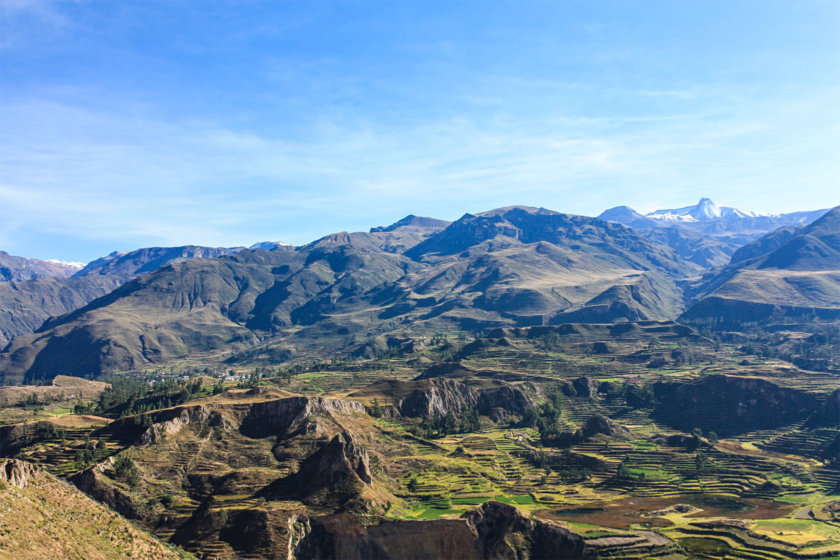
16. Sillar Route
The sillar is the white volcanic stone that characterizes the buildings in the center of Arequipa.
There is a tourist route, called Ruta del Sillar, that allows you to discover its history, the stone extraction process and visit several quarries, such as Añashuayco, Cortadores and Culebrillas, to see the artisans at work.
Some of the works are really impressive!
How to get to La Ruta del Sillar from Arequipa:
The easiest way to get there from Arequipa is to book this trip to La Ruta del Sillar with pick-up at your hotel:
- It is also possible to make a private excursion to visit the Sillar Route
If you prefer to go on your own (without an agency), here are the steps to follow:
- Take a bus after the Grau bridge towards Cono Norte-Yura
- Get off at the Curva bus stop (Plaza Norte shopping center)
- On the other side of the street, take a bus to La Cruz (there are also cabs)
Then walk 10-15 min to the entrance to the Ruta del Sillar and pay 5 soles for the entrance fee.
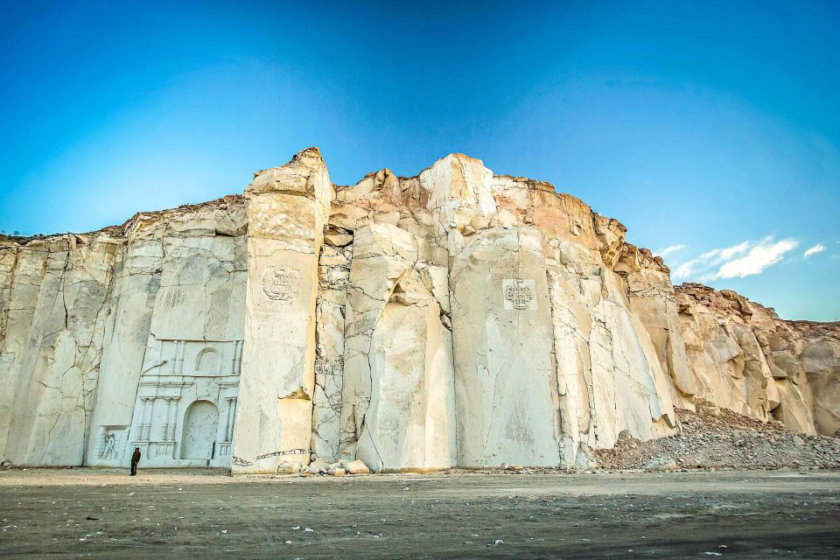
17. Salinas Lagoon
To be honest, I only went there during my last stay in Arequipa because I didn’t have enough time to go back to the Colca Valley.
And what a pleasant surprise! I did not regret my choice at all because the landscapes were sublime.
The salinas Lagoon is a large shallow saltwater lake located at 14,100 ft. above sea level in the National Reserve of Salinas and Aguada Blanca.
It is a huge protected area, surrounded by volcanoes and snow-capped mountains, which is home to many typical Andean animals.
So we went to the Salinas Lagoon to observe several species of pink flamingos that came to enjoy the shallow waters of the lagoon.
With the Pichu Pichu and Ubinas volcanoes in the background, it was like being at the movies! It must be said that the light is especially beautiful at that altitude.
Further on, we were able to walk among a herd of camelids, including some babies (I had never been so close to them, except in a corral, and that doesn’t count!)
We even got to see a vizcache that cute Andean rodent that is usually quite difficult to see because it camouflages itself so well in this environment.
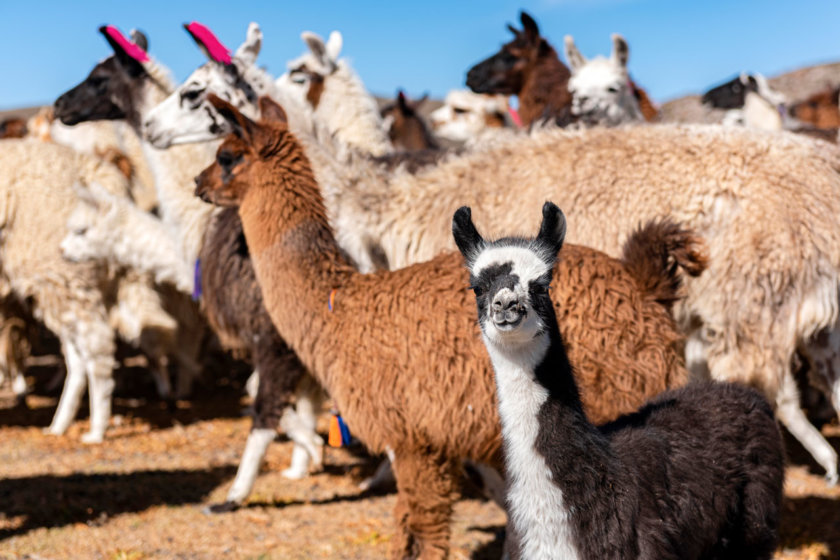
When to go:
I really recommend going during the rainy season (January to March) or right after. This way you will see lots of flamingos and the lake full of water with a nice mirror effect.
In the dry season, the water evaporates to the point that only a large layer of salt remains.
I personally went in April and it was still beautiful, but there were fewer flamingos and less water.
On the other hand, we had great weather, with great blue skies and not a drop of rain. I guess the same can’t be said in the rainy season!
How to get there:
Unless you go by car (and have a good one given the state of the roads), the only way to get there is to hike from Arequipa.
You can book this excursion to the Salinas Lagoon with pick-up at your hotel in Arequipa, the Salinas Lagoon, the village of Chiguata, scenic stops and the hot springs of Lojen:
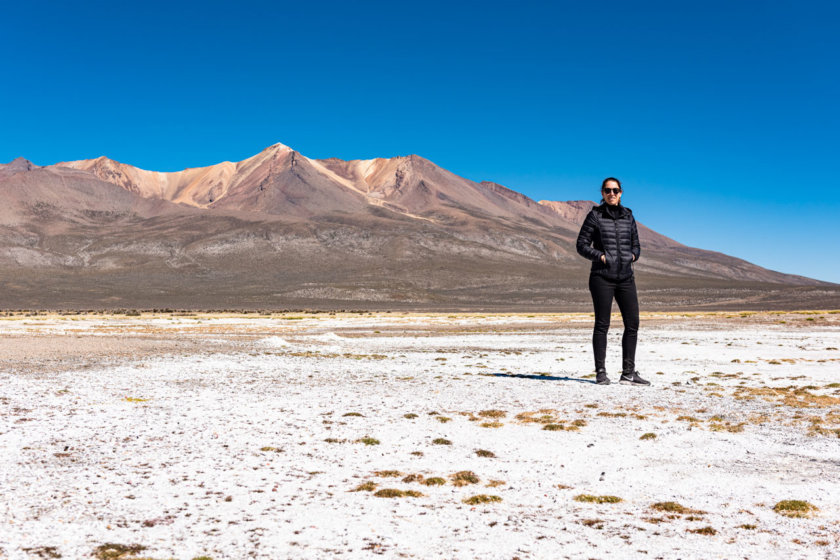
18. The waterfalls of Pillones
The Pillones Waterfalls are surrounded by a forest of stones formed by volcanic erosion.
Be careful, you must have taken the necessary time to acclimatize to the altitude and be in good physical shape, as Pillones is at 15,000 ft. altitude. This makes it a quite demanding excursion for the body, even if it is not a long hike.
How to get to Pillones from Arequipa:
It is possible to get there on your own, but it is a bit complicated (especially to get back) as Pillones is really in the middle of nowhere.
Personally, I recommend taking an excursion from Arequipa, it will be much easier.
But, of course, it’s up to you!
Go to Pillones on your own (without agency):
–Take a bus Arequipa-Juliaca and get off at km 154 (3h) just after the village of Pillones. The other option is to take a cab, but then I suggest you arrange the return time with the same driver.
-Cross the road to the small orange tree house, where you will have to pay 3 soles for the entrance fee
-Then walk 1 km along the RíoPillones (about 20 min* depending on your physical condition)
-To return to Arequipa, you will have to wait for a bus to pass by the roadside (15 soles)
Go Pillones with a tour (with an agency):
This is the easiest way to visit Pillones from Arequipa.
The excursion to Pillones includes pick-up from your hotel in Arequipa, with a stop in the village of Pampa de Arrieros, vicuña watching, coca tea in Patahuasi, the stone forest of Imata and the waterfall of Pillones.
You can book the tour here:
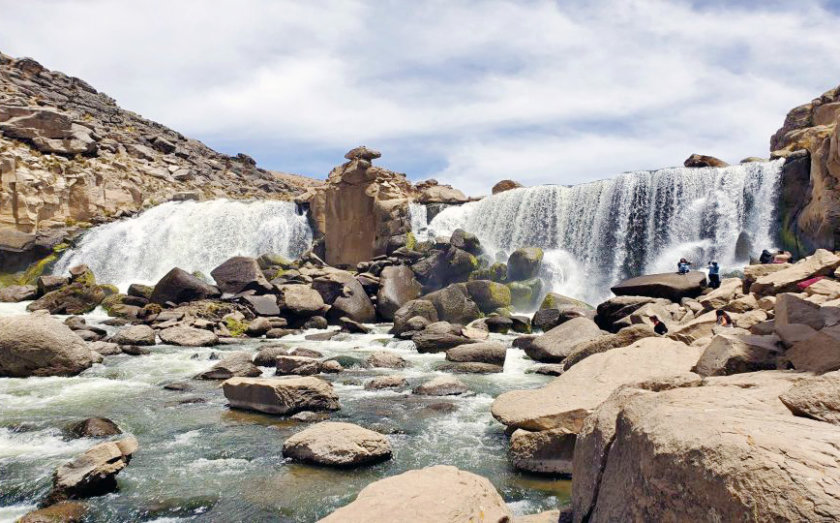
19. Cotahuasi Canyon
Located at 250 miles northwest of Arequipa city, cotahuasi canyon is the deepest canyon in the world (11,600 ft!)
Although the Colca Canyon is much more touristic, the Cotahuasi Canyon also has a lot to offer between hiking, beautiful landscapes and archaeological sites.
Here is a summary of things to do and see in Cotahuasi:
- Sipia waterfall (490 ft), where you can rappel.
- Hiking in Cotahuasi (see below)
- The wari and Inca archaeological ruins, such as Maucallacta, Huaynacotas y Allahuay.
- The Cactus Forest of Judio Pampa. 119 acres with a multitude of cactus, some reaching 40 foot high!
- The hot springs of Luicho, ideal for relaxing after a hike.
- Huito Stone Forest
If you are interested in hiking in Cotahuasi, I suggest you follow this route:
- Day 1: Take a bus from Cotahuasi to Charcana (15h), then hike to Pampamarca (2.5h).
- Day 2: Walk from Pampamarca to Quechualla (6h), passing the Chaupo suspension bridge and the village of Velinga.
- Day 3: Hike from Quechualla to Sipia (4h), then take a bus to Luicho (1h), where you can enjoy the hot springs.
To get to Cotahuasi, you can:
- Take an excursion with an agency from Arequipa
- Take a night bus to the town of Cotahuasi (8-10h) with Transportes Inmaculada or Transportes Reyna.
20. Rafting on the Chile River
If you are looking for some adrenaline, this is one of the best activities to do in Arequipa that is not talked about enough.
The Chile River is a dream place for rafting, especially for beginners, and even for those with an intermediate level (depending on the place and the season).
I had already done rafting in Quebec, but although I loved the experience, it is really nothing like it: here the landscapes are magnificent between volcanoes and agricultural terraces.
It is true that the water is colder due to the altitude, but the guides provide us with all the necessary equipment.
In addition, it is short and sweet as I like it, with 45 min-1h of descent. Just enough to enjoy it without getting too tired.
You can book the rafting excursion here, which includes pick-up at your hotel in Arequipa:
- The best time of the year to go rafting in Arequipa is April to December, outside the rainy season.
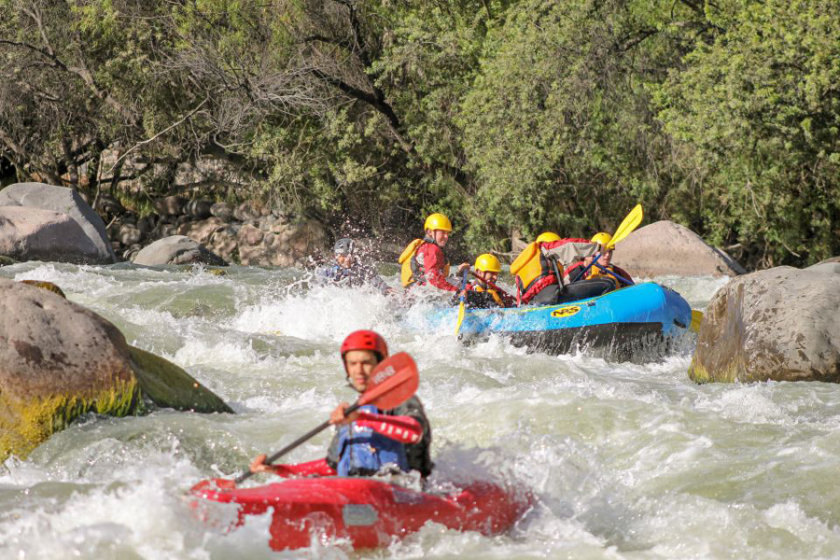
Lodging in Arequipa – Where to stay?
- Arequipay Hostel: Located a few blocks from the Main Square, this hostel offers very clean and bright dormitories. Perfect for budget travelers. Private rooms and shared dorms available. Basic breakfast served daily. From just $8 USD.
- Hotel Tierra Viva: Ideal for mid-range travelers. Just two blocks from the main square, it offers great value with comfortable rooms, Wi-Fi, and buffet breakfast included. From $60 USD per night.
- Hotel Los Tambos: A great choice for those seeking superior comfort. Located just 50 meters from the main square. Stylish rooms and a rooftop terrace with spectacular views of the city. À la carte breakfast with 5 menu options. From $71 USD per night.
- CIRQA – Relais & Châteaux: A stunning luxury hotel in the heart of Arequipa with a restaurant, bar, and rooftop terrace. Breakfast and dinner included with all rooms. From $475 USD per night.
Where to eat in Arequipa: restaurants and cafes
For breakfast, you can’t go wrong with Eco Brunch (great portions and great service) and La Despensa (for good homemade bread).
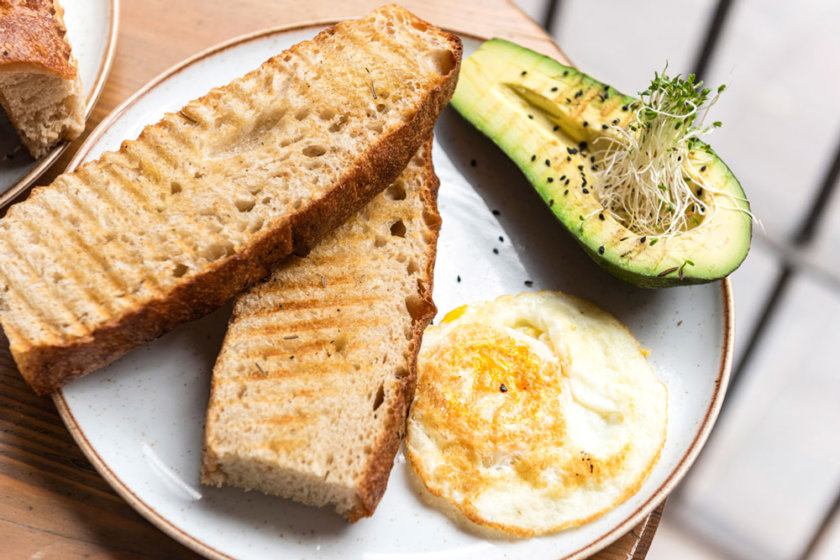
For a good coffee in Arequipa, you can go to the Kafi Wasi coffee shop, Kaffeehaus, with its relaxed terrace, or the beautiful Café Lautrec, with its artistic atmosphere.
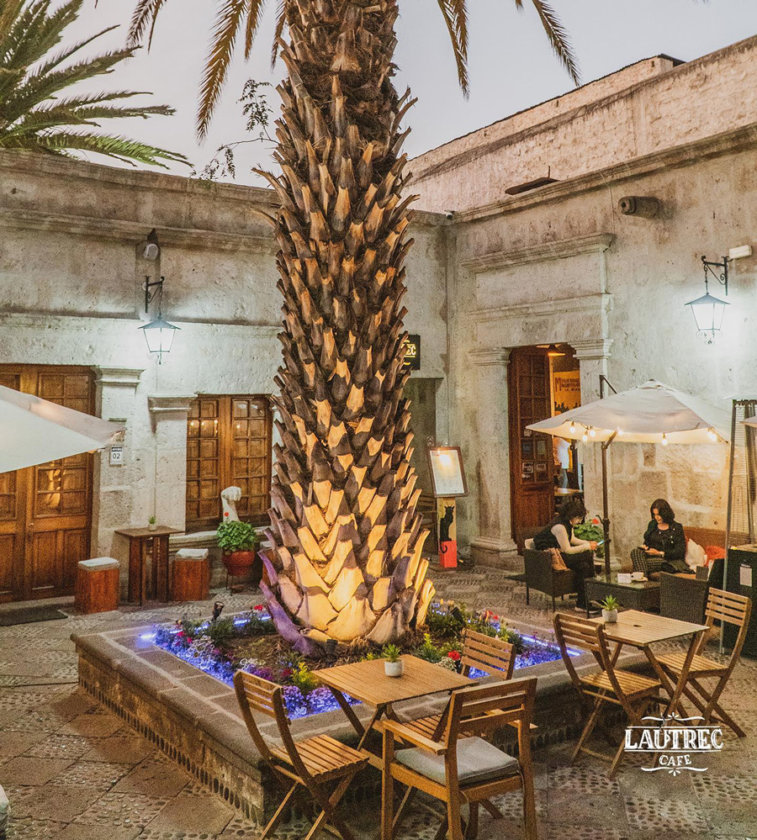
Chaqchao specializes in organic Peruvian chocolate (cookies, bars, cakes, hot chocolate, etc.).
It has a lovely patio, a balcony overlooking Santa Catalina and a good selection of Peruvian craft beers (including those from Cervecería Valle Sagrado, which I love so much!)
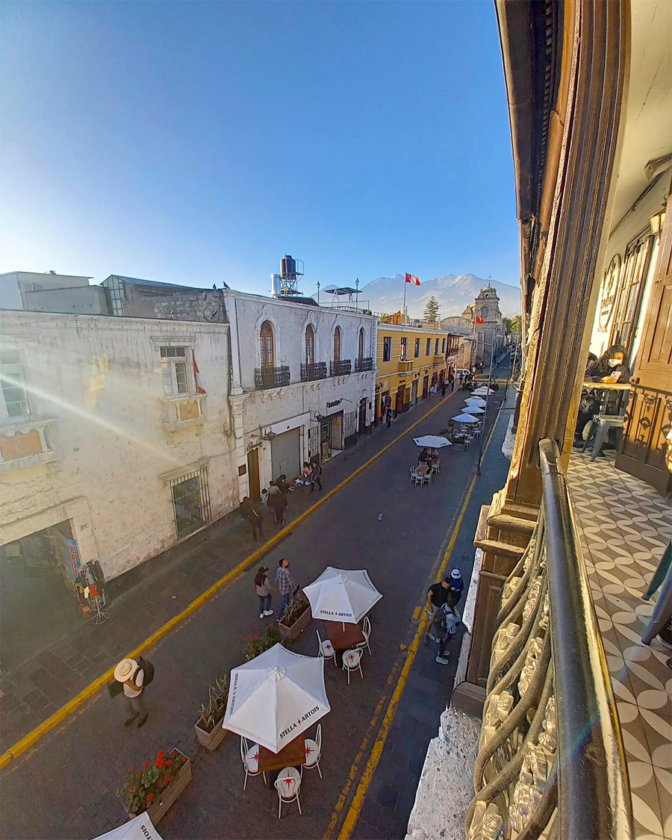
Las Gringas is in the same complex as Chaqchao, in a nice courtyard, and offers wood-fired pizzas made with Peruvian products (quinoa flour, cañihua, purple corn, etc.). With gluten-free, vegan and salad options.
To discover the typical gastronomy of Arequipa, you can go to La Nueva Palomino in Yanahuara or to La Benita de los Claustros in the courtyard of the cloisters of the Company.
- You can discover all my suggestions of restaurants in Arequipa in my Arequipa tourist map!
Where to have a drink in Arequipa
For good craft beer in Arequipa: 7 Vidas Taproom or Chelawasi Public House
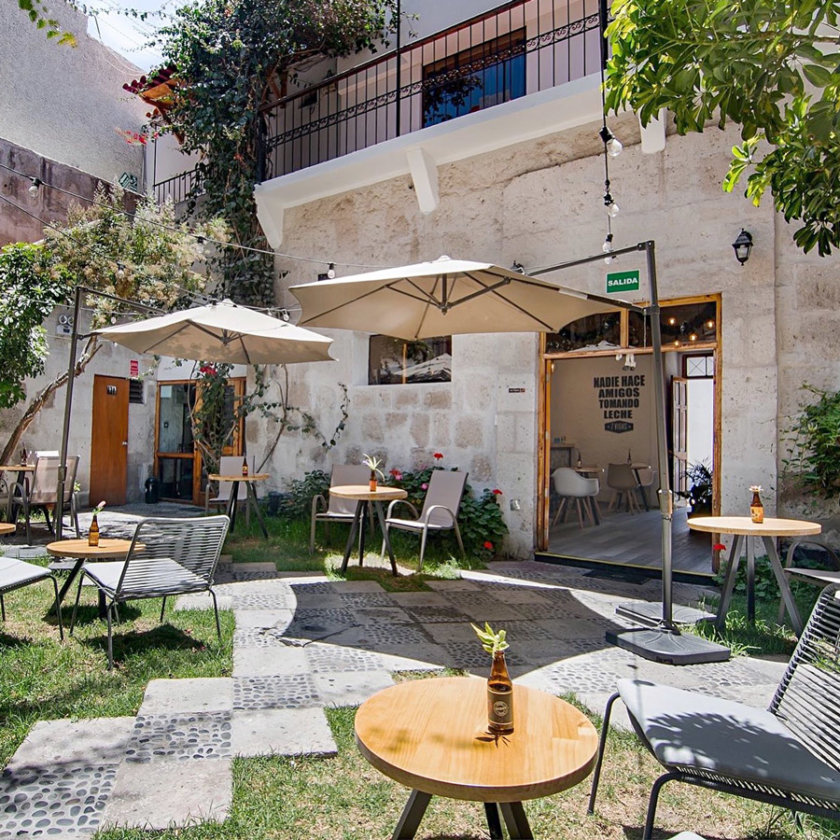
Or the colorful Nowhere, in the San Lazaro neighborhood, with its rooftop terrace.
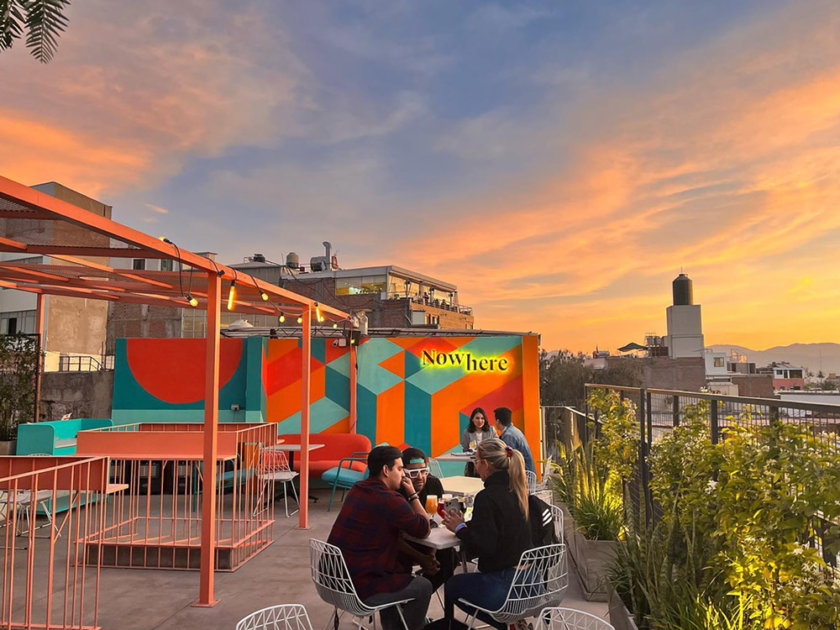
Finally, for good pisco cocktails: the Museo del Pisco is a classic. No, it’s not a museum, but a bar.
I’ve been a fan since they opened (10 years ago!) because they have a varied menu with classics, but also cocktails made with typical Peruvian ingredients (muña, airampo, etc.) for those who, like me, prefer to explore new flavors.
In the evening, when it’s cool, I love to drink their piteado tea, a tea with lemon, honey and pisco. It warms you right up!

Tourist map of Arequipa
Here’s the tourist map of Arequipa with all the places mentioned in this article—including attractions, restaurants, cafés, and bars—to help you plan your visit more easily.
How many days to visit Arequipa?
The ideal is to spend one or two days in Arequipa and then spend 1 or 2 days in the Colca Canyon.
Visit Arequipa in 1 day
This is what I suggest as an itinerary if you only have 1 day in Arequipa:
- In the morning, visit the Santa Catalina Monastery.
- At noon you will have no trouble finding a good restaurant (see my suggestions above)
- In the afternoon, head to the Plaza de Armas.
- Visit the cathedral and climb the bell tower.
- Discover the church of La Compañía and its cloister.
- If you still have time, visit the museum of the Andean Shrines and the Juanita mummy (closes at 6 pm)
If this day in Arequipa is also your first day at altitude, don’t go too fast, take breaks, hydrate well and avoid alcohol.
It is not as high as Cusco (11,150 ft), but Arequipa is still at 7,660 ft and you can feel the effects of the altitude.
Visit Arequipa in 2 days
If you have 2 days in Arequipa, you will be able to enjoy it better and explore different neighborhoods.
Day 1:
- In the morning, start at the Plaza de Armas, with the Cathedral and the Church of the Company of Jesus
- Explore the San Camilo market, the largest in Arequipa.
- Visit the Museo Santuarios Andinos, where the Juanita mummy is located.
Day 2:
- Start the day at the Santa Catalina Convent
- Continue to the Plaza de San Francisco.
- In the afternoon, explore the Yanahuara neighborhood where you can have lunch in a traditional picantería.
- Discover Mundo Alpaca where you can find llamas and alpacas
- Visit San Lazaro, the oldest neighborhood of Arequipa.
When to visit Arequipa?
The best time to visit Arequipa is from May to September (winter in Peru), as temperatures are more pleasant, with sunshine and little rain.
My tips for visiting Arequipa
As in other parts of Peru, it is best to drink bottled water to avoid getting sick.
Don’t forget to wear comfortable shoes to enjoy your stay (this is essential!).
Bring light and warm clothes, as the temperature can vary a lot between day and night, as well as a good sunscreen, a hat and sunglasses, as the sun is very strong at high altitude, although you may not always notice it.
Safety in Arequipa: you can walk around the city center, but always keep an eye on your personal belongings (purse, pockets) and avoid wearing valuables or flashy jewelry (watch, etc.).
How to get to Arequipa?
By bus
You can take a bus from Nazca (12h), Ica (12h), Lima (16h) or Cusco (10h) to Arequipa with several companies such as Cruz del Sur, Flores, Excluciva and Oltursa.
To “lighten the load”, you can add several interesting stops following the following itinerary: Lima – Paracas – Ica (Huacachina) – Nazca – Arequipa.
By plane
The fastest way to get there is to fly directly to Arequipa from Lima (1h), Cusco (1h) or Juliaca (40 min) with Latam, Sky Airline, JetSMART Peru.
The airport of Arequipa airport is located 7.5 miles (20 min) from the city center. It receives flights from Lima, Cuzco, Piura, Trujillo and Santiago (Chile) with Latam, Sky Airlines and JetSmart.
If you want to find a cheap flight ticket to Peru, I recommend you to use our comparator, in collaboration with Skyscanner: it’s the guarantee to get the best price for your international flight and domestic flights!
For from Arequipa airport to downtown Arequipa you can either take a cab (at the airport or on the street), or book a private transfer to your hotel:
Rent a Car in Peru
Renting a car is one of the best ways to explore Peru at your own pace and make the most of your trip!
Personally, I always use Booking.com Cars for a few key reasons:
- Easily compare prices from all major rental agencies in one place—finding the best deal has never been easier!
- Free cancellation on most bookings, so you can reserve with peace of mind.
- Better insurance coverage at a lower price than rental companies—saving you money with no extra effort.
Click the button below to find the best car rental deals in Peru:
Rent a car
Book entrance tickets and guided visits
Take a travel insurance
Book a tour
✈️ Book your flight
Traveling to Peru? These articles will help you!
Discover all my articles about Peru: All my tips and itineraries to plan your trip in one place!
40 EPIC Things to Do in Peru (+ My Best Tips)
- One day itinerary in Arequipa: Best places to visit + Tips
- 2 or 3 Days in Arequipa: The Perfect Itinerary (+ My Tips)
- Colca Canyon: The Definitive Guide (+ My Tips)
- Itinerary: 5-6 days in Peru – Lima, Arequipa, Colca Canyon, Cusco, Sacred Valley and Machu Picchu
- Itinerary: 7-8 days in Peru – See the maximum in one week
- Itinerary: 10 days in Peru – The ideal itinerary for a short stay in Peru
- Itinerary: 2 weeks in Peru – The classic route
- Itinerary: 15 days in Peru – An itinerary that includes northern Peru
- Itinerary: 3 weeks in Peru
- Itinerary: 3 weeks in Peru + Bolivia – The best itinerary for visiting both countries
- Itinerary: 1 month in Peru – What to see and do in 30-31 days
You’re using Pinterest? Here is the picture to pin!
